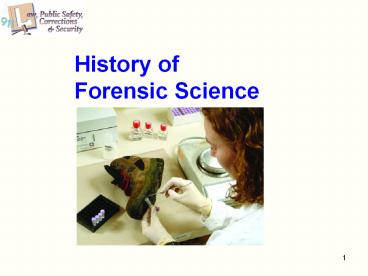History of Forensic Science - PowerPoint PPT Presentation
Title:
History of Forensic Science
Description:
History of Forensic Science * Before 17th century Confrontation by the accuser Confession under torture Strength to resist the pain GUILTY INNOCENT ... – PowerPoint PPT presentation
Number of Views:760
Avg rating:3.0/5.0
Title: History of Forensic Science
1
History of Forensic Science
2
Before 17th century
- Confrontation by the accuser
Confession under torture
Strength to resist the pain
INNOCENT
GUILTY
3
Forensic Science
- the application of science to the court of law
Criminalistics
the application of scientific techniques in
collecting and analyzing physical evidence
4
Early Use of Forensics
- 3rd Century China
- Coroner solved a case where a woman was suspected
of murdering her husband and burned the body - She claimed he died in an accidental fire
- Tested whether or not a body would have ashes in
its mouth if it died in a fire using pigs - When confronted with the coroners evidence, the
woman confessed.
5
Marcello Malpighi
- Professor of Anatomy at University of Bologna in
Italy - Wrote some of the first recorded notes about
fingerprint characteristics in 1686 - But even he didnt see their value as a way to
indentify people
Carl Wilhelm Scheele
- 1775
- Swedish Chemist
- Devised the test for detecting the poison arsenic
in corpses
6
Valentin Ross
- German Chemist
- 1806
- Discovered a more precise method for detecting
small amounts of Arsenic
Mathieu Orfilla
- Spain
- 1814
- Father of Forensic Toxicology
- Published the first scientific treatise on the
detection of poisons
7
1828 The invention of thePolarized Light
Microscope
1839 First microscopic detection of sperm
8
James Marsh
- Scottish Chemist
- 1839
- The first to testify in a criminal trial on the
detection of Arsenic in a victims body - expert witness using science in a legal context
9
- The first presumptive test for blood
1850s 1860s Development in photography and
Improved records in forensic science
10
Alphonse Bertillon
- French Anthropologist
- Introduced the Bertillon System (aka
Anthropometry) in 1879 - Used various measurements of the body to
identify people by their physical appearance - Eventually replaced by fingerprinting
- Also considered father of the mugshot.
10
11
Bertillons Anthropometry
12
What does this picture make you think of?
13
Sherlock Holmes
- Fictional character in books by Sir Arthur Conan
Doyle - First book A Study in Scarlet, 1887
- Popularized using scientific method in solving
crimes - Described elements of newly developing techniques
in serology,
fingerprinting, firearm
examination, and document
examination
14
Francis Henry Galton
- Wrote the first definitive study of fingerprints
and developed a classification system - 1892 published Finger Prints book
Hans Gross
- Austrian prosecutor and judge
- 1893
- Published Criminal Investigation
- Discussed the benefits of science in criminal
investigations
15
Karl Landsteiner
- 1901
- Discovered ABO Blood typing
Albert Osborn
- 1910
- Published Questioned Documents
16
Edmond Locard
- 1877-1966
- French doctor/criminologist
- Developed Locards Exchange Principle
- Opened the very first crime laboratory in France
17
Locards Exchange Principle
- with contact between two items, there will be
an exchange.
18
Walter McCrone
- 1916-2002
- American chemist
- Microscopy expert
- Examined The Shroud of Turin and the Vinland map
19
Sir Alec Jeffreys
- 1984
- Developed first DNA Profiling test
20
History of Crime Labs in the United States
- Los Angeles PD Crime Lab the 1st crime lab in
US - 1930s
- University of CA at Berkeley Dept. of
- Criminalistics headed by Paul Kirk
- FBI Director J. Edgar Hoover opens the FBI
Laboratory - 1981
- FBI opens Forensic Science Research and Training
Center
21
Federal Crime Laboratories
- FBI Laboratory (Quantico, VA)
- Drug Enforcement Administration (DEA)
Laboratories - Bureau of Alcohol, Tobacco, Firearms and
Explosives (ATF) Laboratories - U.S. Army Crime Investigation Laboratory
- (Fort Gillem, GA)
- U.S. Postal Inspection Service Laboratories
22
Crime Labs Abroad
- The British Home Office
- Metropolitan Police Laboratory (London), a.k.a.
Scotland Yard - 5 other regional labs
- Canada
- Royal Canadian Mounted Police (RCMP) Laboratories
- Centre of Forensic Sciences (Toronto)
- The Institute of Legal Medicine and Police
Science (Montreal)
23
Resources
- Saferstein, Richard. Forensic Science An
Introduction. New Jersey Pearson Prentice
Hall, 2008. - Bertino, Anthony J. Forensic Science
Fundamentals and Investigations. Mason, OH
South-Western Cengage Learning, 2009. - http//www.officer.com/publication/article.jsp?pub
Id1id25192
24
Image Sources
- http//theopinionation.net/blog/wp-content/uploads
/2009/06/10-medieval-torture-devices8.jpg - http//www.nndb.com/people/492/000095207/carl-wilh
lem-scheele-1-sized.jpg - http//www.all-about-forensic-science.com/alphonse
-bertillon.html - http//www.fact-archive.com/encyclopedia/upload/th
umb/a/a9/250px-Mathieu_Joseph_Bonaventure_Orfila.j
pg - http//img.directindustry.com/images_di/photo-g/po
larization-microscope-304081.jpg - http//www.historyforkids.org/scienceforkids/biolo
gy/cells/pictures/sperm.jpg - http//en.wikipedia.org/wiki/FileMarsh_James.jpg
- http//blog.bloodonthemotorway.com/wp-content/uplo
ads/2009/10/Blood_Spatter.jpg - http//en.wikipedia.org/wiki/FileMarsh_James.jpg
- http//www.gusto-graeser.info/Monteverita/Personen
/GrossOtto/Hans_Gross.jpg - http//media-2.web.britannica.com/eb-media/75/6897
5-050-00CBB315.jpg - http//www.osbornandson.com/backgnd.html
- http//www.bestforensicscienceschools.com/2009/top
-10-most-famous-forensic-experts-in-history/ - http//www.mcri.org/home/section/2-8/dr.-walter-c.
-mccrone

